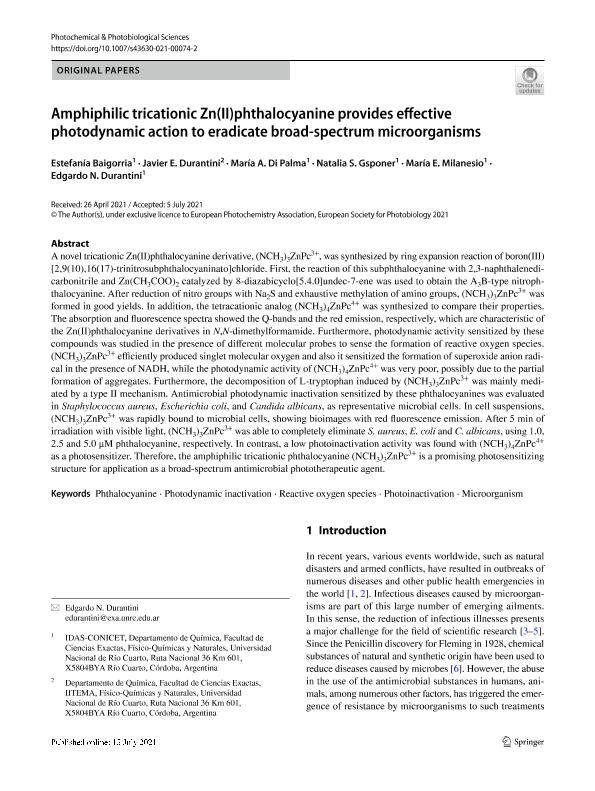Mostrar el registro sencillo del ítem
dc.contributor.author
Baigorria, Estefanía

dc.contributor.author
Durantini, Javier Esteban

dc.contributor.author
Di Palma, María Albana

dc.contributor.author
Gsponer, Natalia Soledad

dc.contributor.author
Milanesio, María Elisa

dc.contributor.author
Durantini, Edgardo Néstor

dc.date.available
2022-04-28T11:55:20Z
dc.date.issued
2021-07
dc.identifier.citation
Baigorria, Estefanía; Durantini, Javier Esteban; Di Palma, María Albana; Gsponer, Natalia Soledad; Milanesio, María Elisa; et al.; Amphiphilic tricationic Zn(II)phthalocyanine provides effective photodynamic action to eradicate broad-spectrum microorganisms; Royal Society of Chemistry; Photochemical and Photobiological Sciences; 20; 7-2021; 939–953
dc.identifier.issn
1474-905X
dc.identifier.uri
http://hdl.handle.net/11336/155971
dc.description.abstract
A novel tricationic Zn(II)phthalocyanine derivative, (NCH3)3ZnPc3+, was synthesized by ring expansion reaction of boron(III) [2,9(10),16(17)-trinitrosubphthalocyaninato]chloride. First, the reaction of this subphthalocyanine with 2,3-naphthalenedicarbonitrile and Zn(CH3COO)2 catalyzed by 8-diazabicyclo[5.4.0]undec-7-ene was used to obtain the A3B-type nitrophthalocyanine. After reduction of nitro groups with Na2S and exhaustive methylation of amino groups, (NCH3)3ZnPc3+ was formed in good yields. In addition, the tetracationic analog (NCH3)4ZnPc4+ was synthesized to compare their properties. The absorption and fluorescence spectra showed the Q-bands and the red emission, respectively, which are characteristic of the Zn(II)phthalocyanine derivatives in N,N-dimethylformamide. Furthermore, photodynamic activity sensitized by these compounds was studied in the presence of different molecular probes to sense the formation of reactive oxygen species. (NCH3)3ZnPc3+ efficiently produced singlet molecular oxygen and also it sensitized the formation of superoxide anion radical in the presence of NADH, while the photodynamic activity of (NCH3)4ZnPc4+ was very poor, possibly due to the partial formation of aggregates. Furthermore, the decomposition of L-tryptophan induced by (NCH3)3ZnPc3+ was mainly mediated by a type II mechanism. Antimicrobial photodynamic inactivation sensitized by these phthalocyanines was evaluated in Staphylococcus aureus, Escherichia coli, and Candida albicans, as representative microbial cells. In cell suspensions, (NCH3)3ZnPc3+ was rapidly bound to microbial cells, showing bioimages with red fluorescence emission. After 5 min of irradiation with visible light, (NCH3)3ZnPc3+ was able to completely eliminate S. aureus, E. coli and C. albicans, using 1.0, 2.5 and 5.0 μM phthalocyanine, respectively. In contrast, a low photoinactivation activity was found with (NCH3)4ZnPc4+ as a photosensitizer. Therefore, the amphiphilic tricationic phthalocyanine (NCH3)3ZnPc3+ is a promising photosensitizing structure for application as a broad-spectrum antimicrobial phototherapeutic agent.
dc.format
application/pdf
dc.language.iso
eng
dc.publisher
Royal Society of Chemistry

dc.rights
info:eu-repo/semantics/openAccess
dc.rights.uri
https://creativecommons.org/licenses/by-nc-sa/2.5/ar/
dc.subject
MICROORGANISM
dc.subject
PHOTODYNAMIC INACTIVATION
dc.subject
PHOTOINACTIVATION
dc.subject
PHTHALOCYANINE
dc.subject
REACTIVE OXYGEN SPECIES
dc.subject.classification
Química Orgánica

dc.subject.classification
Ciencias Químicas

dc.subject.classification
CIENCIAS NATURALES Y EXACTAS

dc.title
Amphiphilic tricationic Zn(II)phthalocyanine provides effective photodynamic action to eradicate broad-spectrum microorganisms
dc.type
info:eu-repo/semantics/article
dc.type
info:ar-repo/semantics/artículo
dc.type
info:eu-repo/semantics/publishedVersion
dc.date.updated
2021-12-03T19:47:22Z
dc.journal.volume
20
dc.journal.pagination
939–953
dc.journal.pais
Reino Unido

dc.journal.ciudad
Cambridge
dc.description.fil
Fil: Baigorria, Estefanía. Universidad Nacional de Río Cuarto. Facultad de Ciencias Exactas Fisicoquímicas y Naturales. Departamento de Química; Argentina. Consejo Nacional de Investigaciones Científicas y Técnicas; Argentina
dc.description.fil
Fil: Durantini, Javier Esteban. Universidad Nacional de Río Cuarto. Facultad de Ciencias Exactas Fisicoquímicas y Naturales. Instituto de Investigaciones en Tecnologías Energéticas y Materiales Avanzados. - Consejo Nacional de Investigaciones Científicas y Técnicas. Centro Científico Tecnológico Conicet - Córdoba. Instituto de Investigaciones en Tecnologías Energéticas y Materiales Avanzados; Argentina
dc.description.fil
Fil: Di Palma, María Albana. Consejo Nacional de Investigaciones Científicas y Técnicas; Argentina. Universidad Nacional de Río Cuarto. Facultad de Ciencias Exactas Fisicoquímicas y Naturales. Departamento de Química; Argentina
dc.description.fil
Fil: Gsponer, Natalia Soledad. Consejo Nacional de Investigaciones Científicas y Técnicas; Argentina. Universidad Nacional de Río Cuarto. Facultad de Ciencias Exactas Fisicoquímicas y Naturales. Departamento de Química; Argentina
dc.description.fil
Fil: Milanesio, María Elisa. Universidad Nacional de Río Cuarto. Facultad de Ciencias Exactas Fisicoquímicas y Naturales. Departamento de Química; Argentina. Consejo Nacional de Investigaciones Científicas y Técnicas; Argentina
dc.description.fil
Fil: Durantini, Edgardo Néstor. Consejo Nacional de Investigaciones Científicas y Técnicas; Argentina. Universidad Nacional de Río Cuarto. Facultad de Ciencias Exactas Fisicoquímicas y Naturales. Departamento de Química; Argentina
dc.journal.title
Photochemical and Photobiological Sciences

dc.relation.alternativeid
info:eu-repo/semantics/altIdentifier/url/https://link.springer.com/article/10.1007/s43630-021-00074-2
dc.relation.alternativeid
info:eu-repo/semantics/altIdentifier/doi/http://dx.doi.org/10.1007/s43630-021-00074-2
Archivos asociados
